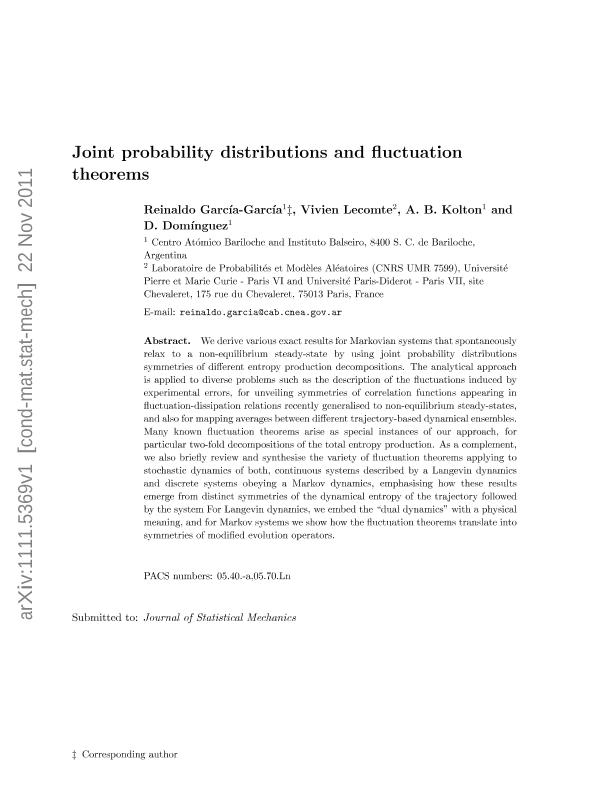Artículo
Joint probability distributions and fluctuation theorems
Fecha de publicación:
02/2012
Editorial:
IOP Publishing
Revista:
Journal Of Statistical Mechanics: Theory And Experiment
ISSN:
1742-5468
Idioma:
Inglés
Tipo de recurso:
Artículo publicado
Clasificación temática:
Resumen
We derive various exact results for Markovian systems that spontaneously relax to a non-equilibrium steady-state by using joint probability distributions symmetries of different entropy production decompositions. The analytical approach is applied to diverse problems such as the description of the fluctuations induced by experimental errors, for unveiling symmetries of correlation functions appearing in fluctuation-dissipation relations recently generalised to non-equilibrium steady-states, and also for mapping averages between different trajectory-based dynamical ensembles. Many known fluctuation theorems arise as special instances of our approach, for particular two-fold decompositions of the total entropy production. As a complement, we also briefly review and synthesise the variety of fluctuation theorems applying to stochastic dynamics of both, continuous systems described by a Langevin dynamics and discrete systems obeying a Markov dynamics, emphasising how these results emerge from distinct symmetries of the dynamical entropy of the trajectory followed by the system For Langevin dynamics, we embed the "dual dynamics" with a physical meaning, and for Markov systems we show how the fluctuation theorems translate into symmetries of modified evolution operators.
Palabras clave:
Entropy
,
Non Equilibrium
,
Fluctuations
Archivos asociados
Licencia
Identificadores
Colecciones
Articulos(CCT - PATAGONIA NORTE)
Articulos de CTRO.CIENTIFICO TECNOL.CONICET - PATAGONIA NORTE
Articulos de CTRO.CIENTIFICO TECNOL.CONICET - PATAGONIA NORTE
Citación
Garcia Garcia, Reinaldo; Lecomte, Vivien; Kolton, Alejandro Benedykt; Dominguez, Daniel; Joint probability distributions and fluctuation theorems; IOP Publishing; Journal Of Statistical Mechanics: Theory And Experiment; 2012; 2-2012; 200901-200937
Compartir




